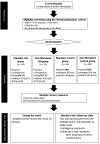Reduced alcohol use increases drink-refusal self-efficacy: Evidence from a contingency management study for DWI arrestees
- PMID: 36493503
- PMCID: PMC9784176
- DOI: 10.1016/j.drugalcdep.2022.109706
Reduced alcohol use increases drink-refusal self-efficacy: Evidence from a contingency management study for DWI arrestees
Abstract
Background: Several therapies and interventions to reduce drinking first target drink-refusal self-efficacy (DRSE) to influence drinking behavior. While higher self-efficacy scores are correlated with better outcomes, it is unclear that increased self-efficacy is the causative step leading to improved outcomes. Instead, this correlation may result from reduced drinking that increased self-efficacy. The current study sought to understand how changes in drinking behavior can influence DRSE.
Methods: Data were from 211 driving while intoxicated (DWI) arrestees participating in an 8-week contingency management (CM) study to reduce drinking. Some of participants were mandated by the courts to wear transdermal alcohol monitoring devices (Mandated group) and some were not mandated (Non Mandated group). All wore a transdermal alcohol monitor during the 8-week study and were randomized to CM or a Control condition stratified by the mandate group. Participants completed weekly assessments of DRSE. Group-based trajectory-modeling identified three drinking behavior trajectory groups.
Results: While there were no differences in baseline DRSE between the three trajectory groups, participants in the low- and moderate-frequency drinking behavior groups significantly increased DRSE across the study.
Conclusion: The present study indicates that being able to maintain abstinence or reduce heavy drinking may increase DRSE.
Keywords: Alcohol; Behavioral intervention; Contingency management; Drink-refusal self-efficacy; SCRAM monitors; Transdermal alcohol concentration.
Copyright © 2022 Elsevier B.V. All rights reserved.
Conflict of interest statement
Competing interest statement The authors do not have any competing interests to declare.
Figures





Similar articles
-
Effectiveness of contingency management using transdermal alcohol monitoring to reduce heavy drinking among driving while intoxicated (DWI) arrestees: A randomized controlled trial.Alcohol Clin Exp Res (Hoboken). 2023 Oct;47(10):1989-2001. doi: 10.1111/acer.15180. Epub 2023 Sep 13. Alcohol Clin Exp Res (Hoboken). 2023. PMID: 37864527 Free PMC article.
-
One month follow-up outcomes of a transdermal alcohol concentration-based contingency management intervention to reduce heavy drinking among driving while intoxicated arrestees.Alcohol Clin Exp Res (Hoboken). 2025 May;49(5):1166-1176. doi: 10.1111/acer.70047. Epub 2025 Mar 31. Alcohol Clin Exp Res (Hoboken). 2025. PMID: 40165510
-
The effect of the 'What Do You Drink' web-based brief alcohol intervention on self-efficacy to better understand changes in alcohol use over time: randomized controlled trial using ecological momentary assessment.Drug Alcohol Depend. 2014 May 1;138:89-97. doi: 10.1016/j.drugalcdep.2014.02.009. Epub 2014 Feb 20. Drug Alcohol Depend. 2014. PMID: 24613632 Clinical Trial.
-
A cognitive model of binge drinking: the influence of alcohol expectancies and drinking refusal self-efficacy.Addict Behav. 2004 Jan;29(1):159-79. doi: 10.1016/s0306-4603(03)00076-5. Addict Behav. 2004. PMID: 14667427 Review.
-
The effectiveness of alcohol monitoring as a treatment for driving-while-intoxicated (DWI) offenders: A literature review and synthesis.Traffic Inj Prev. 2021;22(sup1):S1-S7. doi: 10.1080/15389588.2021.1980783. Epub 2021 Oct 21. Traffic Inj Prev. 2021. PMID: 34672885 Review.
Cited by
-
Effectiveness of a self-help guide during a temporary alcohol abstinence challenge: a randomized controlled trial.Alcohol Alcohol. 2024 May 14;59(4):agae034. doi: 10.1093/alcalc/agae034. Alcohol Alcohol. 2024. PMID: 38798161 Free PMC article. Clinical Trial.
References
-
- Babor TF, & Higgins-Biddle JC (2001). Brief Intervention for Hazardous and Harmful Drinking: A Manual for Use in Primary Care. World Health Organization, 53.
-
- Beck AT (1970). Cognitive therapy: Nature and relation to behavior therapy. Behav Ther, 1(2), 184–200. 10.1016/S0005-7894(70)80030-2 - DOI
Publication types
MeSH terms
Substances
Grants and funding
LinkOut - more resources
Full Text Sources
Medical

